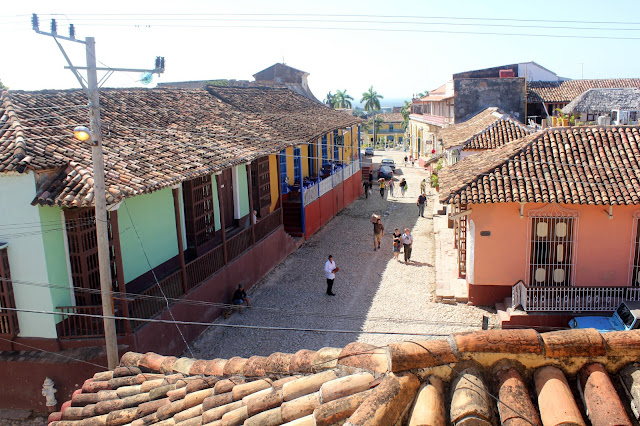Trinidad, Cuba. One of the oldest towns in Cuba and also one of the best preserved. A UNESCO World Heritage and a reminder of the wealth generated by sugar cane production in the Caribbean. A town of cobblestone streets and pastel colored colonial houses, where one in every three houses is a museum.

Trinidad is utterly gorgeous. Wherever you look, the combination of colors, colonial architecture, terracota roofs and the general Cuban feel make the atmosphere intoxicating.
Since the moment you set foot in Trinidad you notice two things:
1. The town is amazingly beautiful and worth the trouble to come all the way to Sancti Spiritus province
2. It is also a bit of a tourist trap, with all the prices in restaurants, shops, casas particulares... higher than in any other place in Cuba.
Point 2 is not nice, but Point 1 really compensates for it! If you get frustrated over paying a bit more, you can just look around, feel the atmosphere and relax.
Trinidad does not have clear highlights. There are a couple places where you can go to see beautiful views, a couple of museums which show the opulence of life in the town some centuries ago... but the main thing to do here, as in other places in Cuba, is just to walk around and observe and calmly sense the town vibe.
There is a central square with the main church and lots of museums and one of the best Casa de la Musica in Cuba with daily live performances. This is downtown proper. Around this plaza, everything looks beautiful thanks to UNESCO and tourism money. However, outside of the few blocks which compose the town center, the town is really run down. Another constant in Cuba. This is another reason why the city center acts like a magnet and brings you back before long.


We went to Trinidad for New Year's Eve. In our recent experience, New Year's Eve in the countryside of developing countries is something to be remembered. It is the time and place when and where traditions can be felt more intensely. For example, food. The typical Cuban food for New Year's Eve is roasted piglet. When we arrived in Trinidad, we saw many people in the streets putting wooden sticks literally through the piglets... it was quite a rough view and definitely an experience. Afterwards, the animals were roasted for many hours, slowly, in the streets. There were old guys turning the pigs from time to time and offering conversation to passers-by: they had to be sitting there the whole day! At night, all menus in Trinidad included this delicious meat.

Another interesting tradition was water throwing. The pass from one year to the next is celebrated with fireworks and a big party, as in many places. However, the peculiarity in Cuba is that people must throw water buckets to the streets to clean their houses and keep them free from bad influences, spirits and the like.
So if you are in Cuba for New Year's Eve, be careful if you see a door opening... they won't think twice before showering you! Actually, we saw groups of small children walking around in reckless attitude trying to get soaked.
In terms of logistics, Trinidad is 6 hours away from Havana by
Viazul bus. Most of the trip is on a nice highway, but the last 100 km or so are on very local winding roads. In our case, we did not have a reservation for the bus so when we showed up there, the bus was full and there were no available seats on sale. We could wait until the bus departure to see if there were some actually empty seats, which is normal... However, after our pleasant taxi experience from Viñales to Havana, I decided to go out of the terminal and talk to the taxi drivers. After a long and hard negotiation, I got a taxi driver with a nice new car for the same price as the bus if I could find one more passenger. Of course, it just took one minute to convince one person among those waiting for empty seats in the Viazul bus. So in the end, it just took us 4 hours to get to Trinidad and it was much more comfortable! (I will talk more about the best the way to move in Cuba, in my opinion, when I talk about Santa Clara - promised!)


Just before closing time, shops were full of people, foreigners and locals alike, trying to get the last supplies for the upcoming party. Of course, we also stocked on soft drinks, snacks and a bottle of Havana Club. Rum in Cuba is cheap, very cheap... dirty cheap! For around 3 USD you can get a bottle of rum in tourist shops! so I really cannot imagine what is the price for locals in the largest supermarkets!
The night was falling onto the town...
... and roasters were finishing their jobs one more year...
In our Casa Particular (
Hostal Rintintin), we enjoyed a nice buffet dinner with some Italians. The buffet was nice, with lots of seafood, roasted pork and the usual Cuban food for tourists...
... it was a little bit pricy, but still cheaper than in any other place in town, and anyway, it was New Year's Eve!!! Yuuhi soon got asleep, so we got stuck in the hostel and could not go outside for a long time, but Lorenzo, the owner, babysitted him for around 30 minutes and we could go out and see what was going on in the streets. And back in the hostel, he invited us to some beers :)
The next day, the town was completely empty, recovering from the excesses of the previous night...
... and thanks to the fact that we had had to sleep early to take care of our son, we had all of the town for ourselves in the ealy morning!




































































